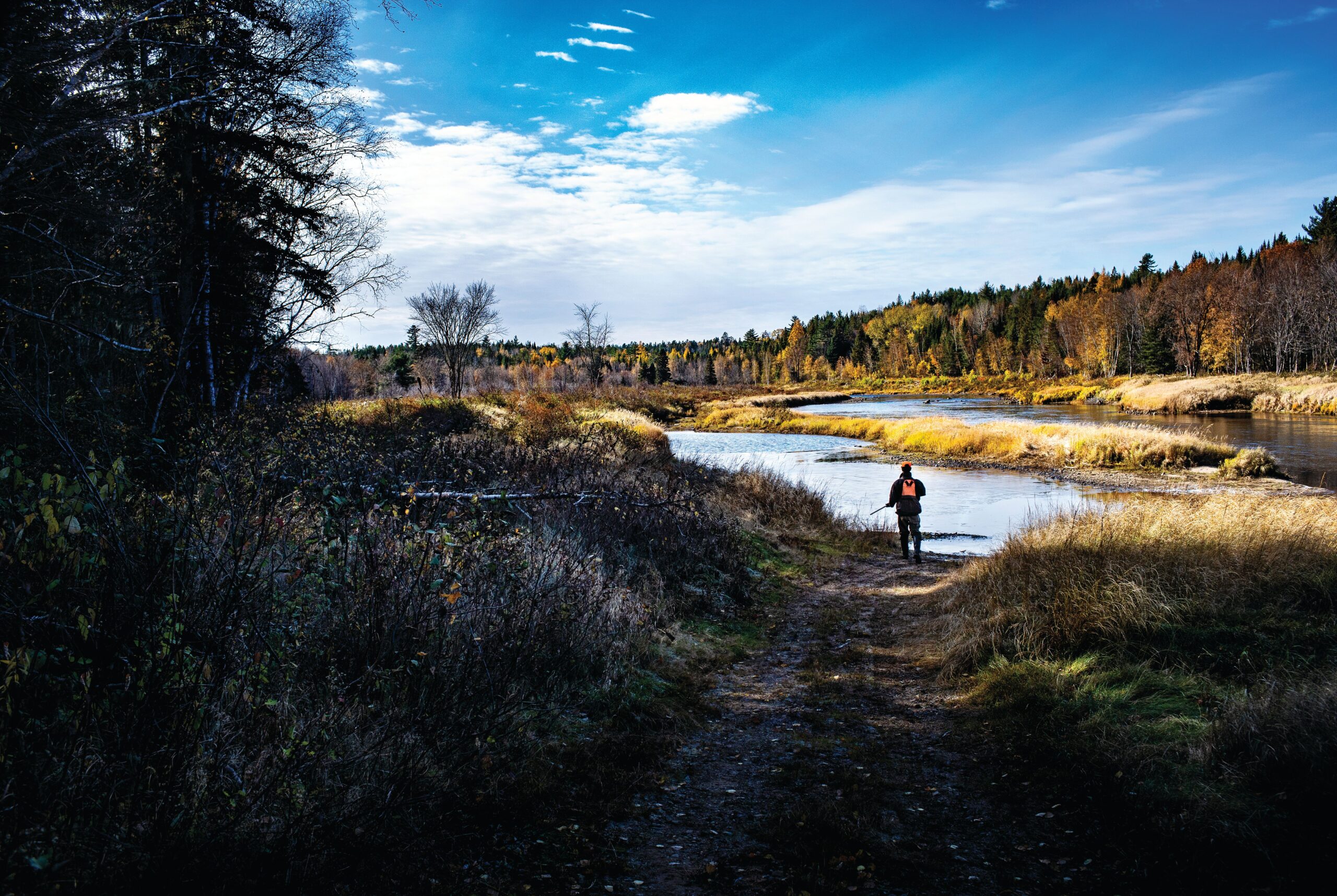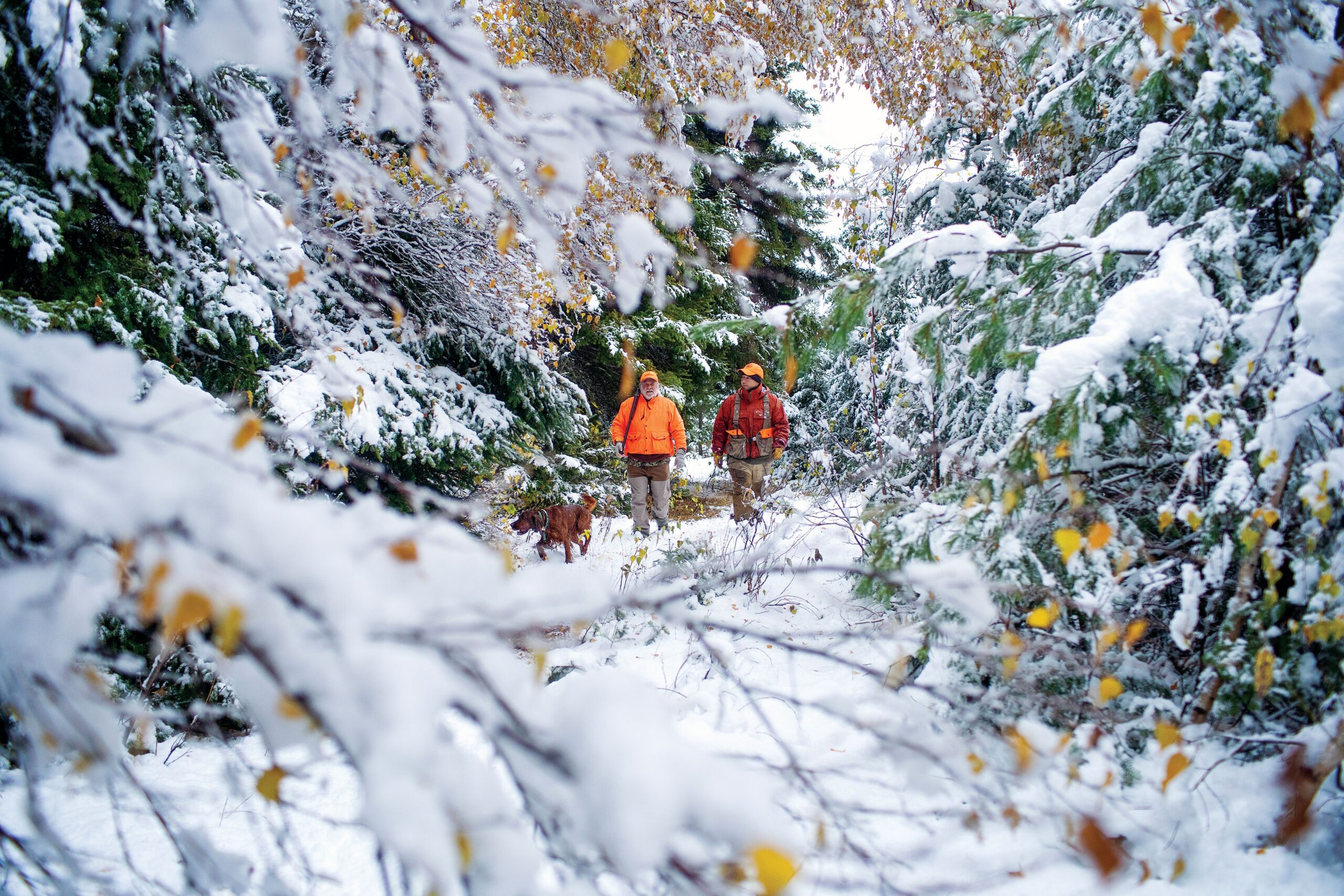Wizards of the Northwoods

“Have you ever hunted woodcock and grouse in Canada?” That was what my buddy Vic said to me when I told him I was looking for something new and different in a bird-hunting adventure. “I know a great little spot up in New Brunswick, and we should go.”
Six months later, he called and said he had it booked. “It’s just like quail hunting, only a little boggier. Bring some waterproof boots!” I heard him laugh as he hung up the phone. This was the beginning of my relationship with the wizards of the Northwoods: the American woodcock and the ruffed grouse.
The similarities of shooting quail compared to woodcock and grouse are many…and very few. It’s easy to assume that you have the bird-hunting thing figured out just because you’ve hunted quail for years in Georgia, pheasants in the Dakotas, and partridge on the plains. Maybe you’ve been to Argentina for doves and South Africa for guinea fowl—but hunting woodcock and grouse is completely different. The magical baton that causes one to fall under the spell of this sport gets dutifully passed from friend to friend, father to son, and grandfather to granddaughter, but it’s no cake walk, and it’s not for everyone. When someone says, “It’s just like quail hunting,” the trap is laid, and you can’t help but take the bait.

I arrived at The Ledges Lodge a day before Vic and his friend Raeford would be there, so the owner, Everett Taylor, took me out for an afternoon hunt by myself. We drove out a few miles from the lodge, he put his dog Rufus on the ground, and he motioned me towards the thicket he wanted me to enter. My first reaction was, “You’ve got to be kidding!” However, the dog went in, and Everett went in, so I realized he was serious. I turned my back to the seemingly impenetrable wall of skinny saplings and bramble, trying to protect my gun and my face, and pushed my way through.
Less than 10 minutes later, Rufus’s bell went silent, which meant he was on point. I fought my way over towards him, and halfway there, with my leg in a tangle, a woodcock flushed. It fluttered up softly right in front of me, too close to shoot I thought, and then it took off like a rocket in a corkscrew pattern and disappeared! I fired two shots pointlessly into the trees. A few minutes later a grouse flushed, according to the guide. I heard the rattle of wings but saw nothing. This scenario continued for a few more flushes with me obviously shooting “blank cartridges,” and Rufus looking at me with disapproving eyes as we walked along with no birds in the bag. Finally, two grouse flushed out front, and amazingly I hit them both. I heard a sigh of relief from Everett and salvaged a little of my credibility with the pooch. When we returned to the lodge, Everett was touting my skills to the others who had arrived, and I learned more about his family and the lodge during our dinner.
Everett’s great, great grandfather migrated to Canada from Scotland and became an outfitter, guiding hunters for caribou. The family started a dairy farm, and over the next seven generations they acquired more cattle and 500 acres of land. Eventually, Everett’s mother took over the farm, and Everett learned to guide salmon fishermen and upland hunters from America. The family sold the dairy farm about 20 years ago and built the current lodge to focus on the outfitting business. Now, most all of Everett’s clients are repeat visitors—some for as many as 62 years. Everett and his wife, Carolyn, who runs the hospitality side of things, treat everyone like family—all visitors feel at home the second they arrive.

The next morning was bright and sunny. Vic and I were paired up to go out, and all went well. Vic masterfully shot several grouse, and I finally managed to figure out how to hit a woodcock. Andrew, our guide, put out a nice field lunch, and life was good. But when afternoon arrived, the birds started up with their tricks. A grouse flushed right under Vic’s feet and flew over our heads and behind us, Vic’s gun caught in the bramble, and I fell over trying to turn sideways and spin at the same time. Then, four consecutive woodcock pulled a disappearing act when they flushed, making fools of us all. Our inflated egos shrunk back to molecule size.
The following morning, the weather turned, and Raeford and I went out in a torrential downpour. It was raining so hard it was laughable. I couldn’t see anything, my boots filled up with water, and looking up was impossible. We went through some super-thick cover next to the river, and birds were everywhere! Every 10 minutes Andrew would yell “woodcock,” and I would see a gray flash through the bear branches. I’d throw my gun up, pull the trigger, and lo-and-behold, the bird would fall. Raeford was doing the same, and we had our limit in less than an hour! Mind-boggling…

Quail hunting? For starters, it’s not a whole lot like quail hunting. “Well,” my buddy Gil says, “there is a gun and a dog and a flying object involved, but that’s about it.” Yes, if you can hit a quail, that’s a good start. You are better off with a light, quick-pointing gun that’s made for snap-shooting. The cover is much thicker, and you typically are in a deep forest of birch, aspen, or big conifers of some sort. Normally, you or the guide can tell by watching the dog when he’s birdy, but when the dog points, it usually means a bird is within a 10- to 15-yard area, so it could flush behind you or way out in front. It doesn’t take much of a hit to knock one down. You literally have a split second from the time you see a glimpse of the bird to identify it, get the gun up, and pull the trigger, or your chance is over! You need to have pellets already in the air when you see the bird, but since that’s impossible, many times you shoot up in the foliage in the direction the bird is headed, and surprisingly the bird will fall. Quail surprise you, pheasants run, and chukar and partridge see you coming. Woodcock can turn your soul inside out and ruffed grouse can read your mind.
Grouse are locals, while woodcock are tourists. The woodcock is an amazing gamebird. They migrate, flying at night to the next spot, usually 50 miles away, but sometimes as far as 300. These birds do not seem to be aware of or alarmed by your presence. They are just doing their thing, digging around in the bog for worms and bugs. They seem more annoyed than frightened when they are interrupted. But when they flush, they flutter straight up for 8 or 10 feet like tiny ascending angels, looking almost like a wounded bird. Then, they take off like demons as you fire twice at a spot where they aren’t anymore.
The grouse are a completely different story. They hear you coming, see you coming, and read your mind. They are sometimes nonchalant, just standing on the ground watching you walk up or sitting in a tree as you slowly creep up thinking you’ve got one already in the bag. Then they do the exact opposite of what you’ve planned and escape many times without you even firing a shot.

A year later, back at The Ledges Lodge with Vic and my college buddies Gil and Bob, we woke up to a surprise. A 12-inch blanket of fluffy white snow had fallen overnight, and the temperature had dropped. The guides and dogs had supposedly never hunted birds in these conditions so anything could happen. The woods were magical with the softness of the snow, so sounds were muted, and the birds were even more tricky. However, they were easier to see when they flushed with the stark-white backdrop. That morning went well in the beautiful winter wonderland. We quickly connected with several grouse and added a couple of woodcock to the bag. That afternoon, we managed to knock down a few more birds before our wet gloves were frozen solid. Then, Bob slipped and fell in the creek, so we headed back to the lodge.
That night, we had our usual cigar and whiskey session around the firepit. Vic cued up an obscure Uriah Heep tune on a bluetooth speaker to toast our adventures with the Wizards of the Northwoods. Bob looked around while ringing out his drenched socks and said, “If our quail-hunting buddies back home could see what we go through to get these birds, they’d think we’d lost our minds! And to be honest, it does help to be half crazy!”
Yeah, it’s just like quail hunting…only you are a ballerina, doing a pirouette with boots in a bog, sliding sideways onto a thornbush, while trying to shoot a bird that’s way smarter than you are. I’ve been back every year since!
Originally published in Volume 9, Number 6 (October-November 2021) of Covey Rise.
























